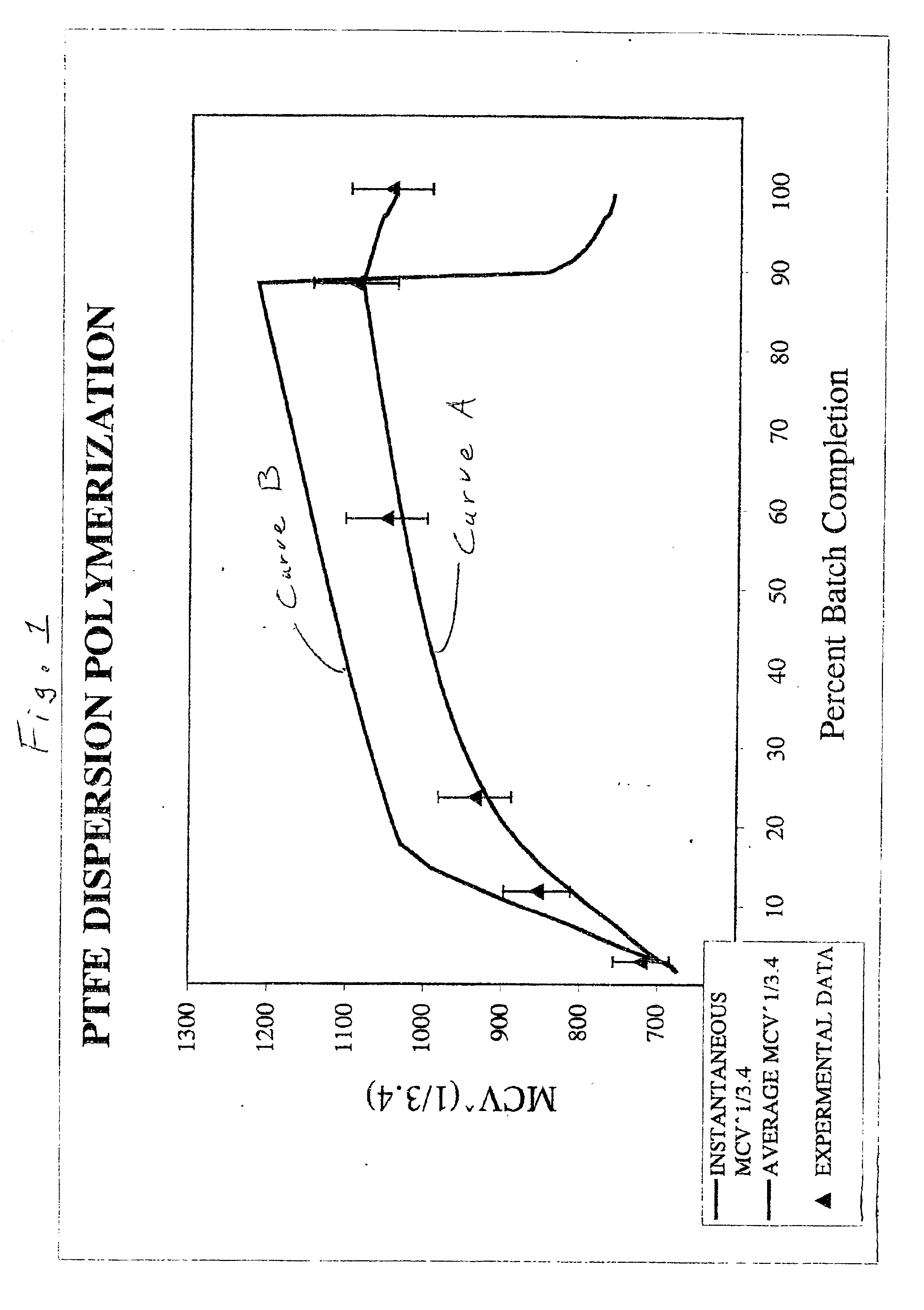Core-shell fluoropolymer dispersions
a fluoropolymer and shell technology, applied in the field of dispersions, can solve the problems of shell creating problems in dispersion coating applications, unable to melt process to form films and coatings, and unable to meet the needs of flex life, etc., and achieves the effect of improving the flex life of the coating and high shear stability
- Summary
- Abstract
- Description
- Claims
- Application Information
AI Technical Summary
Benefits of technology
Problems solved by technology
Method used
Image
Examples
example 1
This Example illustrates the polymerization of TFE to make fluoropolymer particles of this invention having a high molecular weight core of PTFE with a low molecular weight shell of PTFE. A polykettle having a horizontal agitator and a water capacity of 240 parts by weight is charged with 123.5 parts of demineralized water and 5.82 parts of a paraffin wax supplied by Exxon. Into the evacuated polykettle are charged, 3.24 parts of a solution containing 0.0616 parts of ammonium perfluorooctanoate. The contents of the polykettle are agitated at 50 rpm. The temperature is increased to 90 C. TFE is then added until the pressure is 2.72 MPa. Then 1.29 parts of a fresh initiator solution of 0.01 parts of disuccinyl peroxide (DSP) and 0.00005 parts of ammonium persulfate (APS) per part of water are added at the rate of 0.129 part / min. Once the pressure has declined by 0.1 MPa, the batch is considered to have kicked off. TFE is added at a rate sufficient to maintain the pressure at 2.72 MPa....
example 2
The same procedure and essentially identical amounts of ingredients are used as in Example 1 except that the concentration of the ammonium perfluorooctanoate originally charged is increased to 0.1 part per part of water and the pumped ammonium perfluorooctanoate solution is reduced in concentration to 1 weight %. The solids content of the raw dispersion is found to be 45.5% and the RDPS is found to be 268 nm. A hand measurement of 328 particles from a SEM image shows pills and rod-shaped particles of average length of 325 and diameter 195. The particles whose length is greater than 5 times the diameter have an average length of 770 nm and diameter of 78 nm. The fraction of rod-shaped particles comprises 4.9% and by weight assuming cylindrical geometry is 1.9%. The PTFE resin obtained has an SSG of 2.2217. The dry resin is a free flowing powder. The resin is paste extruded at a reduction ratio of 1600:1 to give a continuous extrudate and an extrusion pressure of 29.4 MPa. The beading...
example 3
The same procedures and essentially identical amounts of ingredients are used as in Example 2 except that the concentration of the ammonium perfluorooctanoate originally charged is decreased to 0.08 parts per part of water and the pumped ammonium perfluorooctanoate is increased in concentration to 2 weight %. The solids content of the raw dispersion is found to be 45.3% and the RDPS is found to be 283 nm. The PTFE resin obtained has an SSG of 2.209. The concentrated dispersion containing 6 weight % Triton® has a CCT of 22.9 micrometers and a gel time of greater than 1800 seconds. At 8 weight % Triton® the CCT improves to 34.5 micrometers.
PUM
| Property | Measurement | Unit |
|---|---|---|
| melt creep viscosity | aaaaa | aaaaa |
| melt creep viscosity | aaaaa | aaaaa |
| number average particle size | aaaaa | aaaaa |
Abstract
Description
Claims
Application Information
 Login to View More
Login to View More - R&D
- Intellectual Property
- Life Sciences
- Materials
- Tech Scout
- Unparalleled Data Quality
- Higher Quality Content
- 60% Fewer Hallucinations
Browse by: Latest US Patents, China's latest patents, Technical Efficacy Thesaurus, Application Domain, Technology Topic, Popular Technical Reports.
© 2025 PatSnap. All rights reserved.Legal|Privacy policy|Modern Slavery Act Transparency Statement|Sitemap|About US| Contact US: help@patsnap.com


